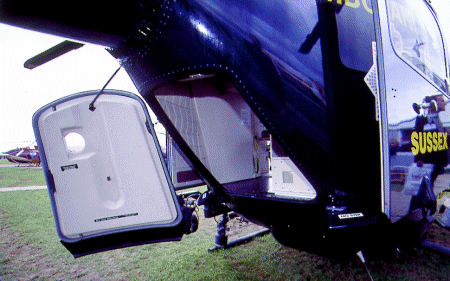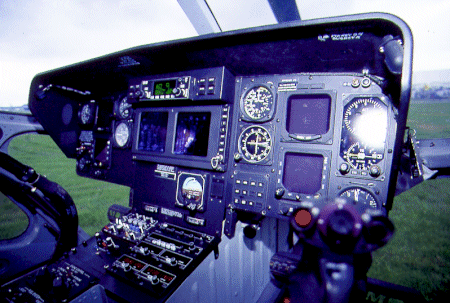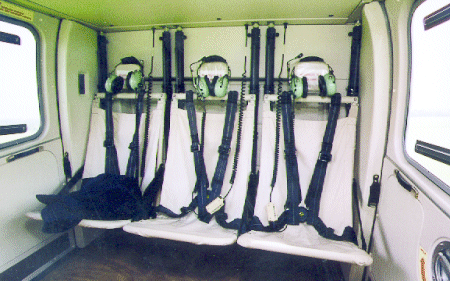Peter Gray/REDHILL

The MD Explorer should be the perfect helicopter. The design was conceived in the early 1990s when McDonnell Douglas asked owners round the world what they wanted in a new helicopter. Their common desire was for a light, multi-purpose, twin-engined machine with good performance that was affordable, dependable, safe and friendly to the environment.
The original MD 900 entered service in 1994. The improved MD 902 followed four years later, after McDonnell Douglas had been merged into Boeing. The Explorer, along with the rest of the former McDonnell Douglas civil helicopter line, was acquired last year by Dutch company MD Helicopters. Flight International was invited by the new owner to evaluate the MD 902 at the Helitech exhibition in the UK last month (Flight International's MD 900 flight test appeared in the 31 August, 1994, issue).
As well as determining whether the helicopter meets its original design criteria, I was looking for ease of management by the pilot - especially for single-pilot instrument flight rules (IFR) operations, for which the MD 902 is certificated. I was also looking for passenger comfort - not just the seats, but noise and vibration levels; for efficiency - how fast and how far it will go on a few litres of fuel; and for ease of maintenance.
The most striking impression on seeing the Explorer is its lack of a tail rotor. An anti-torque tail rotor is a necessary evil on most other helicopters, the worst characteristic being its vulnerability to the potential hazards of striking or being struck by a solid object - which invariably causes sudden and often lethal damage. And all tail rotors are noisy.

The MD 900/902 has the unique NOTAR anti-torque system. This uses an engine-driven fan to slightly compress the air in the hollow tailboom, forcing it out of slots in the boom to mix with the rotor downwash. This generates a sideforce on the boom which provides 60-70% of the sideways thrust required to counteract rotor torque in the hover. The rest of the directional control is provided by a rotating thruster on the tail cone, which is also fed with air provided by the fan. Two vertical fins on the horizontal stabiliser provide most of the anti-torque reaction in forward flight and are independently controlled by a fly-by-wire system. Moving the collective lever automatically adjusts the fan, thruster and fins to compensate for the torque change. The fins also move to augment turn co-ordination and directional stability.
The Explorer's five-blade rotor is bearingless and all composite, with swept tips to reduce noise and increase aerodynamic efficiency. Whereas the loads generated by a helicopter rotor are usually borne by the main drive shaft and gearbox, on the Explorer they are absorbed by the static mast support system. This is a unique safety feature.
Full power
Two Pratt & Whitney Canada PW206Es provide excellent twin- and single-engine performance. Although weighing only about 100kg (220lb), each produces a thermodynamic 545kW (730shp). This is restricted in the MD 902 to single-engine maximum of 505kW for 2.5min because of gearbox considerations. Nevertheless, full power is available to high temperatures and altitudes. Maximum Category A take-off weight for heliport/elevated helipad operations (the most demanding of performance criteria) is unrestricted up to 27°C at sea level , or up to 3,200ft (980m). These limits are raised for clear airfield operations.
For underslung load operations with a long line, which puts the aircraft outside ground effect (OGE) for pick-ups and drops, the maximum aircraft weight is increased by 295kg to 3,130kg with 1h of fuel plus some reserve. At its operational empty weight of 1,465kg, the MD 902 will hover OGE at sea level up to 38°C and carry 1,300kg on the external load hook. In the Andes mountains, where the temperature can be as high as 15°C at 8,000ft, the aircraft will lift an impressive 870kg on the hook.
As well as Class 1 Category A performance (the highest rating), safety features include the crash-tolerant undercarriage, fuselage and fuel system; crashworthy seats for all occupants with five-point harnesses for the two front seats; a dry-run capability for the main gearbox, also designed not to enter the cabin in a heavy landing; no use anywhere of flammable magnesium; no height/velocity restrictions up to 2,725kg aircraft weight and 7,000ft and only a small one thereafter; and protection against lightning strikes and high-intensity radiated fields.
Good visibility
Before installing myself in the right-hand captain's seat, I entered the passenger compartment through the 1.32m-wide cabin door and noted its large size and good visibility. The seats can be folded up or removed in about 3min with no tools. The rear baggage compartment will hold 1.38m3 (48.6ft3) - more than the competing Eurocopter EC135 (1.1m3) and Agusta A109 (0.95m3). Access is through a rear door and there is no tail rotor to worry about if the helicopter is being loaded with the rotor turning.

The initial impressions of the cockpit are of roominess and outstanding all-round visibility - I was to test the latter further in steep turns. The only item overhead is the rotor brake and this is tucked out of harm's way and out of line of sight. The other outstanding impression is of the cockpit's simplicity, even though our aircraft was equipped for two-pilot IFR operations.

The main reason for this simplicity is the Canadian Marconi integrated instrumentation display system (IIDS). This provides everything the pilot needs to know about all the operating systems in easy to interpret analogue and digital form on two liquid crystal displays (LCDs). The primary LCD also has a two-line alphanumeric display for warnings, cautions and advisory messages. There is no master caution light.

Cautions are in yellow and usually require no immediate action. More severe events are in captioned red and have an audio alert. Pilots say that, since the alphanumeric display area is normally blank, any message is noticed immediately. I would be interested to find out if this also applies when the pilot is using night vision goggles or is using the vertical reference technique, with his head out of the cockpit.
The IIDS computer also performs engine trend analysis, records all exceedances and calculates in-flight rotor and NOTAR fan balance solutions, eliminating the need for special track and balance flights with special equipment. Stored data can be downloaded.
All switches and controls are forward of the pilot's shoulder and within easy reach. The uniquely shaped cyclic-pitch stick is hinged below the floor, allowing the pilot to move the stick to any extreme and still keep his forearm resting on his thigh, a useful technique for precision hovering and instrument flying. The collective-pitch lever has a friction release under the head, accessible to one's middle finger. It must be depressed to release the lever.
Controls for those systems that need adjustment or management in flight, such as changing radio frequency, are positioned on the stick and lever so that the pilot does not have to remove his hands from the controls. The external power receptacle was visible by my right foot, so there was no danger of taking off with it still plugged in. I could also see the fuel cap from my seat. The electrical system is DC, keeping it simple.
My pilot was Don Smith, MD Helicopter's chief pilot. The weather was good and Redhill airfield's density altitude was 1,000ft. As there is never any ballast available at air shows to bring aircraft up to maximum weight, we took Flight International's commercial air transport editor, Max Kingsley-Jones, along with us on the flight.
Our resulting weight was 2,375kg, compared with the maximum of 2,835kg. Smith carried out his start-up flow pattern, which took just a few seconds, before inviting me to select "ground idle" on the number two engine using the full-authority digital engine control (FADEC) panel. In a hurry, "flight" can be selected and the same is true for the second engine. Then aircraft will be ready to fly in as long as it takes to start the engines and accelerate to flight RPM. The manual twist-grip throttles stay permanently in the "flight" position until required for manual control.
Although surrounded by other expensive machinery on show at Helitech, Smith had such confidence in the aircraft that he invited me to come to the hover, perform a 180° turn and hover taxi to the active runway behind us. With a five-bladed articulated rotor system, this was no problem and my take-off and hover were satisfactory, requiring little effort. A glance at the IIDS quickly showed how much power we were using and how much was available - both useful parameters for helicopter pilots. We had single-engined hover capability.
Max comfort

Once airborne, and while still quite heavy, I pulled maximum continuous power in straight and level flight and recorded a true airspeed of 143kt (265km/h). This compares well with competing helicopters, which mostly settle somewhere between 140kt and 150kt. I went to the VNE of 140kt to check vibration levels, especially during turns. These were benign, thanks to various anti-vibration systems. Kingsley-Jones was comfortable in the back during these manoeuvres. We then did prolonged steep turns at 60° bank, working the rotor hard to reveal any deficiencies. All was sweet and vibration-free. Visibility in the turn was outstanding.
At the maximum-range cruise speed of 115kt, I asked Smith to select one engine to ground idle. I did nothing, and the RPM fell only slightly, from 100% to 97%. We galloped along, still at a healthy speed. To observe the FADEC's effectiveness, I invited Smith to raise and lower the collective lever as quickly as he dared. The FADEC did a good job, containing power turbine and rotor RPM changes to within 3%. There was no change of fuselage attitude, which can occur during such an exercise.
Smith switched off the stabilisation with the aircraft trimmed for straight and level flight and hands and feet off the controls. The aircraft held its attitude for a while before banking to the right. With the stabilisation back on, the aircraft flew itself quite accurately. The primary hydraulic system which powers the directional servo-actuator was then switched off. I could detect little difference in handling.
A reversion to manual throttle was simplicity itself - in reality, a FADEC failure will freeze the throttle setting at the point of failure and the IIDS will show what has happened and, importantly, to which engine. In manual mode, the throttle was wound back to create a small torque split, allowing the good engine to do all the governing. We made an approach to the hover, then landed. To prevent a possible overspeed, the throttle was reduced to ground idle as weight came on to the undercarriage. A single pilot, even in instrument conditions, will have no difficulty with manual engine management.
The FADEC has a single-engined training mode and there is a graph in the flight manual to establish a training weight. When training mode is selected, one engine will decelerate to 92% power turbine speed, but remains ready to accelerate to full power if there is a problem with the remaining engine. Full single-engine power is available on the good engine, unlike some other helicopters which only go to maximum continuous, so the handling pilot has to be careful not to exceed any single engine limits. In a real failure, the IIDS will automatically rescale to single-engine configuration.
On the way back to Redhill, we did an autorotation which produced a rate of descent of 2,300ft/min (12m/s). Smith says there is plenty of anti-torque pedal available. I then evaluated the usual manoeuvres of spot turns, hovering and landing out of wind, and fast sideways and backwards flight. The aircraft handled well with no unpleasant surprises. We achieved about 35kt sideways before reaching full pedal. This speaks well for the NOTAR system's efficiency.
We then landed on a 10° slope, in all four directions - including downslope, which you would not normally attempt with a tail rotor. Handling was good throughout.
The $3.1 million Explorer has received US and European certification, and is claimed to be the quietest twin on the market. MD Helicopters calculates the direct operating cost as $368.65 an hour. In my opinion, the MD 902 fulfils all of the original design criteria and mine. I found it vice-free and pleasant to operate.
Source: Flight International
















